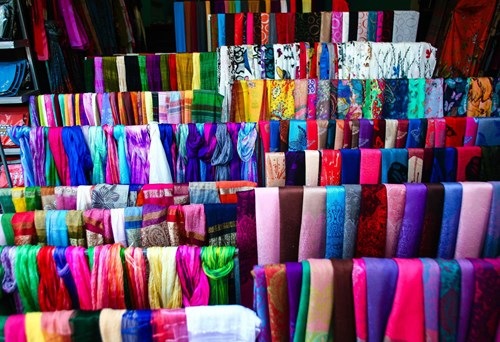According to archaeological documents, the Vietnamese people have practiced breeding silkworms and weaving silk for around 5,000 years. Legend at Co Do village in Ba Vi district, Hanoi said that this industry has dated back to the Hung King VI.
    |
 |
|
Vietnam's colorful silk products |
Meanwhile, archaeological evidence found in China proved conclusively that silkworm breeding and weaving appeared in China in 3,000 BC, even in 6,000 BC. In 2007, archaeologists unearthed specimens of dyed silk in a tomb in China’s Jiangxi province, proving the existence of silk in Dong Zhou Dynasty (around 2,500 years ago). In addition, the “silk road” which linked Indian subcontinent, the Middle East, Europe and North Africa in commerce proved the early existence of silk in China.
A famous legend in Vietnam tells that My Nuong Thieu Hoa, daughter of the Hung King VI, was specially gifted to communicate with birds and butterflies. While talking with butterflies, My Nuong knew that mother butterflies laid eggs which later generated into silkworm larvae which ate mulberry leaves and produced silk threats. She asked to take the silkworm larvae home and weave them into pieces which were named “silk”. She also named the insect producing threads “silkworm” and these names have been passed down from generation to generation.
While studying Bau Tro archaeological relic in Dong Hoi district, Quang Binh province, archaeologists found a terracotta weaving plumb which dated back 5,000 years. The Book of Han wrote that the Lac Viet people planted mulberry trees and raised silkworms and they had two rice crops and eight broods of silkworms. According to other Chinese ancient books, by cross-breeding, the Vietnamese people were able to create new varieties of silkworms which could adapt to different types of weather. As a result, the Vietnamese had eight broods of silkworms, while China had only three.
Centuries ago, the country had developed many intensive production areas, especially traditional villages. Therefore, soft and delicate silk products of Vietnam demonstrated the specific specialty of handicraft industry in Vietnam.
One of the most famous silk production village in Vietnam is 10-century old Van Phuc in Hanoi. In the past, the village’s soft silk products gained popularity among people in the Nguyen Dynasty. In 1931, its first products were brought to the world at Marseille Fair and highly praised by French customers. Van Phuc silk products have been well-known for their delicacy, fresh colors and varied patterns which are appropriate for people of different age groups. In 2011, Van Phuc Silk Village was awarded “Thang Long Golden Brand”.
Traditional villages in Vietnam have different techniques of growing mulberry trees and subsequently weaving the silk. For example, villagers in Duy Xuyen silk village in Ho An city feed silkworms by mulberry leaves which are planted in deep forests in Quang Nam province. That’s why silk products in the village are softer than that of other localities. In addition, the Cham people in Duy Xuyen village also developed their own weaving technique, showing special Champa traditional cultural features of Quang Nam people.
Tan Chau village in An Giang province is another prime example of unique silkworm breeding method. Villagers feed silkworms by mulberry leaves and use mulberry branches for silkworms to create oval cocoons. Local people also dye silk products with a mixture created from diospyros mollis fruits, so the products’ colors are natural, unique and difficult to fade.
In recent years, the silk production industry in Vietnam has seen healthy development after the decrease in the number of traditional silk villages. The achievement is resulted from the expansion of production scale of traditional villages and the increase in silk prices in the world.
At present, Vietnam has a large area of land covered with mulberry trees, 10,000 hectares. In addition, silk productivity has increased thanks to favorable weather condition and technological achievements. Lam Dong province is a prime example. Silkworm breeders harvest 18-20 broods of silkworms per year and 2.5 tons of cocoon/hectare.
At present, Lam Dong, Kon Tum, Dac Nong, Phu Tho, Thai Binh, Lao Cai and Son La are considered the main silk production hubs in Vietnam.
Translated by Tran Hoai